When Rage Against the Machine exploded onto the music scene in the early 1990s, they were an anomaly. No band sounded quite like them. They fearlessly merged rock and rap, bridging a gap that seemed insurmountable at the time. More than just a musical fusion, their lyrics were a Molotov cocktail of radical politics, ignited in a decade perceived as peaceful, sandwiched between the Cold War and the seismic shift of 9/11. While their contemporaries often delved into personal introspection, Rage turned outwards, amplifying the voices of the marginalized, railing against injustice in America and oppression across the globe.
Chuck D of Public Enemy, a key influence on the band, perfectly captured their impact in 2016: “It was one of those rare instances when the planets just lined up right and the alchemy of musical magic and history just poured out,” he said. “I saw them in concert [early on], and what I remember most is how wiped-out the crowd was afterwards. I had never seen a place destroyed; sweat and blood on the walls. The fucking tables were turned over and rafters pulled down. It was crazy. They’re the Led Zeppelin of our time.”
Despite disbanding in 2000 after just three albums of original material, Rage Against the Machine’s songs have only gained resonance in the turbulent decades that followed. Their music anticipated the chaos and social unrest of the 21st century with uncanny accuracy. Their reunion tour, eagerly awaited and repeatedly delayed by the pandemic, finally launched on July 7th, with tickets vanishing instantly. While new music remains elusive, their existing catalog feels more vital and relevant than ever. Rage Against the Machine crafted a soundtrack for our times long before we knew we needed it. Here, we delve into their discography to rank their 25 greatest songs.
-
25. ‘Darkness’ (1994)
Image Credit: Mick Hutson/Redferns/Getty Images
“Darkness,” an early example of Rage Against the Machine’s raw power, first appeared on their 1991 demo tape. It evolved into a more polished, major-label version, complete with Tom Morello’s signature chaotic and electrifying guitar solo, for the soundtrack of the 1994 film The Crow. Initially titled “Darkness of Greed,” this track, which masterfully blends mellow jazz-funk verses with a robust metallic groove, tackles the devastating AIDS crisis in Africa. The song directly criticizes the U.S. government’s perceived inaction and “procrastination” in addressing the epidemic, framing it as a form of genocide. Zack de la Rocha’s chilling whisper, “They say, ‘We’ll kill them off, take their land, and go there for vacation,'” underscores the song’s powerful message of social commentary and political rage. —D.K.
24. ‘How I Could Just Kill a Man’ (2000)
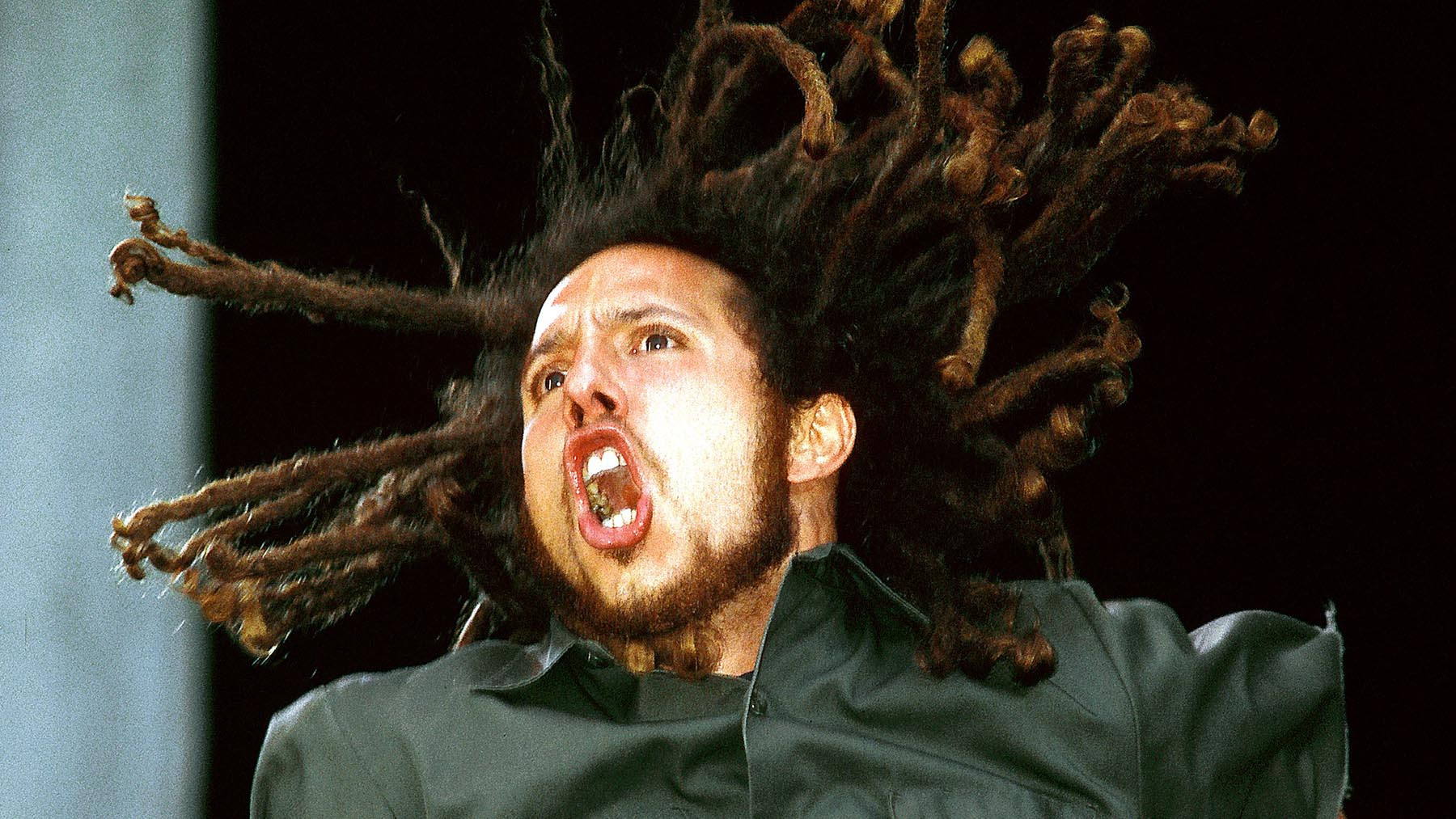 Rage Against The Machine performing at Reading Festival in the UK, August 1, 1993.
Rage Against The Machine performing at Reading Festival in the UK, August 1, 1993.
Image Credit: Mick Hutson/Redferns/Getty Images
Cypress Hill’s breakthrough single, “How I Could Just Kill a Man,” was a raw and unfiltered depiction of street violence, with rappers B-Real and Sen Dog trading verses about retribution and intimidation. The original track’s dark funk was amplified when Rage Against the Machine covered it for their Renegades album. Zack de la Rocha took on all the verses, delivering them with his characteristic intensity, while Tom Morello and bassist Tim Commerford, self-proclaimed “tim.com” on the record, pushed the sonic boundaries to deafening levels, particularly on the chorus. Tim Commerford acknowledged Cypress Hill’s influence, stating, “The first Cypress Hill record and [Public Enemy’s] It Takes a Nation of Millions to Hold Us Back were two of the biggest hip-hop influences on Rage Against the Machine.” Rage Against the Machine’s rendition of “How I Could Just Kill a Man” is a testament to their ability to absorb and transform their influences into something uniquely their own, resulting in a powerful and explosive cover. —K.G.
23. ‘Maggie’s Farm’ (2000)
Image Credit: Brian Rasic/Getty Images
Bob Dylan’s “Maggie’s Farm,” written in 1965, marked his departure from the folk scene and can be interpreted as a defiant statement against those who wanted him to remain creatively stagnant. The lyrics, “Well, I try my best to be just like I am, but everybody wants you to be just like them,” resonate with themes of artistic freedom and resisting external pressures. Rage Against the Machine’s cover of “Maggie’s Farm” on their Renegades covers album arrived at a similar crossroads for the band. Internal tensions were rising, and Zack de la Rocha’s delivery of the line, “I ain’t gonna work at Maggie’s Farm no more,” could be seen as a foreshadowing of his eventual departure from the band. Rage’s rendition transforms Dylan’s folk protest into a hard-rock anthem, mirroring their own internal struggles and rebellious spirit. —A.G.
22. ‘War Within a Breath’ (1999)
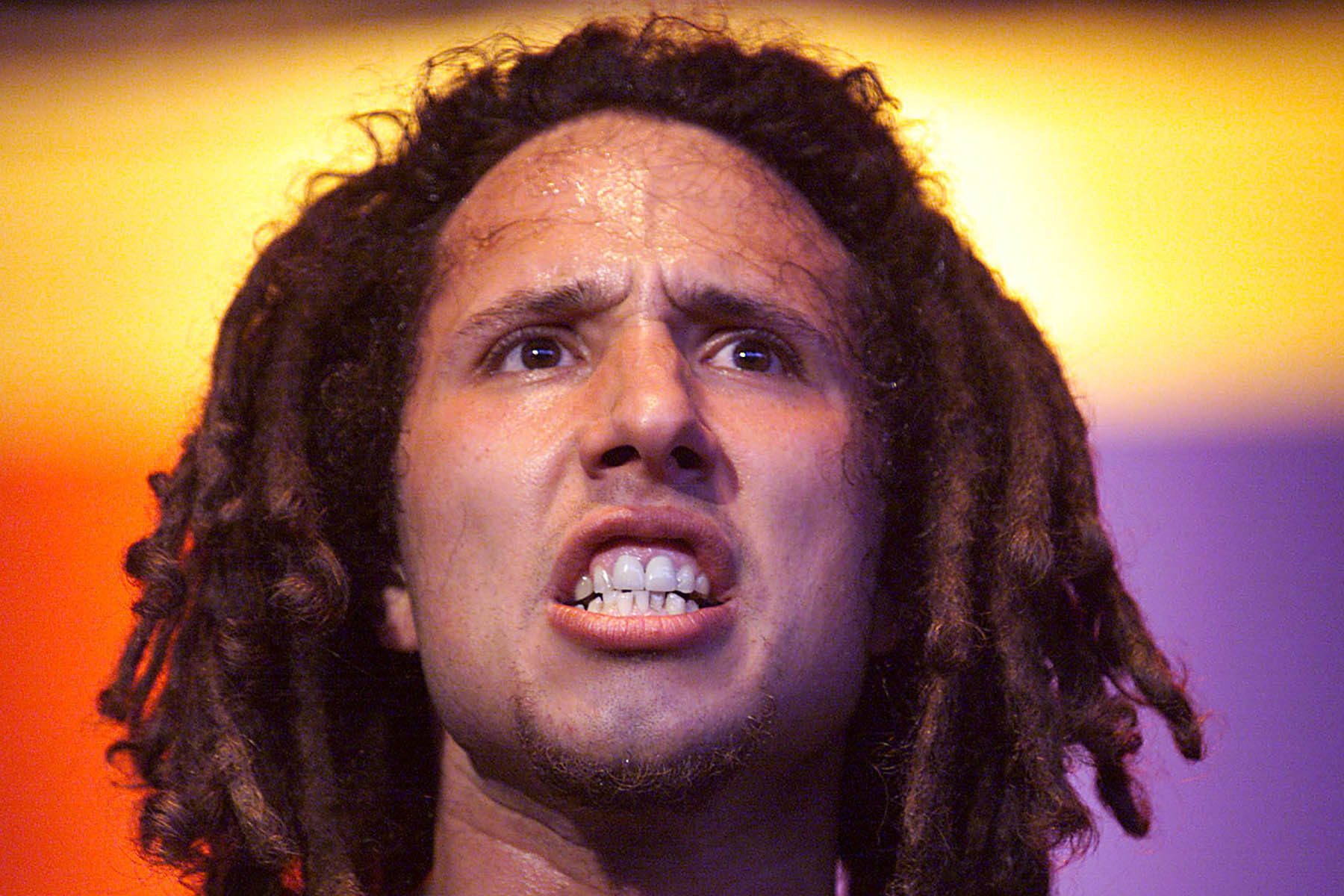 Zack De La Rocha passionately performing on stage at the Tibetan Freedom Concert, Wisconsin, 1999.
Zack De La Rocha passionately performing on stage at the Tibetan Freedom Concert, Wisconsin, 1999.
Image Credit: Frank Micelotta/Getty Images
“War Within a Breath” serves as the closing track on Rage Against the Machine’s final album of original material, The Battle of Los Angeles (1999), poignantly marking the last notes of their distinctive sound to date. The song encapsulates the band’s core ethos in just three and a half minutes, touching upon global struggles from the Zapatista movement to the Palestinian Intifada. It’s a quintessential Rage track, embodying their political awareness and solidarity with oppressed peoples worldwide. De la Rocha’s powerful lyrics, “Every official that comes in, cripples us, leaves us maimed, silent and tamed,” and “with our flesh and bones, he builds his homes,” coupled with the rallying cry, “Southern fist, rise through the jungle mist,” deliver a potent message of resistance and defiance against systemic oppression. —A.G.
21. ‘Settle for Nothing’ (1992)
Image Credit: Michael Putland/Getty Images
Rage Against the Machine’s self-titled debut album is known for its relentless sonic assault, making “Settle for Nothing” a standout track due to its stark contrast. It’s arguably the closest the band ever came to a power ballad, offering a moment of introspection amidst the album’s aggressive energy. Built around an eerily somber riff reminiscent of Metallica’s “One,” the song narrates the internal conflict of a young person drawn to gang life as an escape from a traumatic home environment. The lyrics, “I’ve got a nine, a sign, a set, and now I got a name…”, depict the allure of gang affiliation as a twisted form of belonging. De la Rocha’s voice escalates to a desperate howl, “Death is on my side… suicide!”, before the band erupts into a sinister, Black Flag-meets-Black Sabbath sonic landscape. Morello’s delicate, clean-toned guitar solo adds a haunting layer, creating a warped jazz-like lament for the cycle of violence the song portrays. —H.S.
20. ‘Microphone Fiend’ (2000)
 Tom Morello performing with Rage Against The Machine at the Tibetan Freedom Concert, Wisconsin, 1999.
Tom Morello performing with Rage Against The Machine at the Tibetan Freedom Concert, Wisconsin, 1999.
Image Credit: Frank Micelotta/ImageDirect/Getty Images
Rage Against the Machine launched their Renegades covers album with a thunderous rendition of Eric B. and Rakim’s hip-hop classic, “Microphone Fiend.” While the original sampled the funky guitar intro of Average White Band’s “School Boy Crush,” Tom Morello unleashed his own devastating wah-wah infused guitar fury for Rage’s version. Bassist Tim Commerford anchors the track with a powerful riff, driving the song’s relentless energy. Zack de la Rocha adapted the lyrics, adding a more rock-oriented chorus, and notably omitted Rakim’s self-aggrandizing lines, showcasing a rare instance of hip-hop humility. This cover became a rap-rock hit, highlighting Rage’s ability to seamlessly blend genres and deliver a powerful sonic punch. —K.G.
19. ‘Calm Like a Bomb’ (1999)
Image Credit: Frank Micelotta Archive/Getty Images
“Hope lies in the smoldering rubble of empires,” Zack de la Rocha spits in “Calm Like a Bomb,” a blistering track from The Battle of Los Angeles. This lyric perfectly encapsulates Rage Against the Machine’s overarching philosophy before the song broadens its scope to address the global struggles of the underclass. Lines like, “Stroll through the shanties and the cities’ remains/The same bodies buried hungry/But with different last names,” paint a vivid picture of worldwide inequality and suffering. “Calm Like a Bomb” is also a showcase for Tom Morello’s mastery of the DigiTech Whammy pedal. He conjures impossibly warped and searing waves of sound from his guitar, creating a sonic landscape as explosive and volatile as the song’s lyrical themes. —D.E.
18. ‘The Ghost of Tom Joad’ (2000)
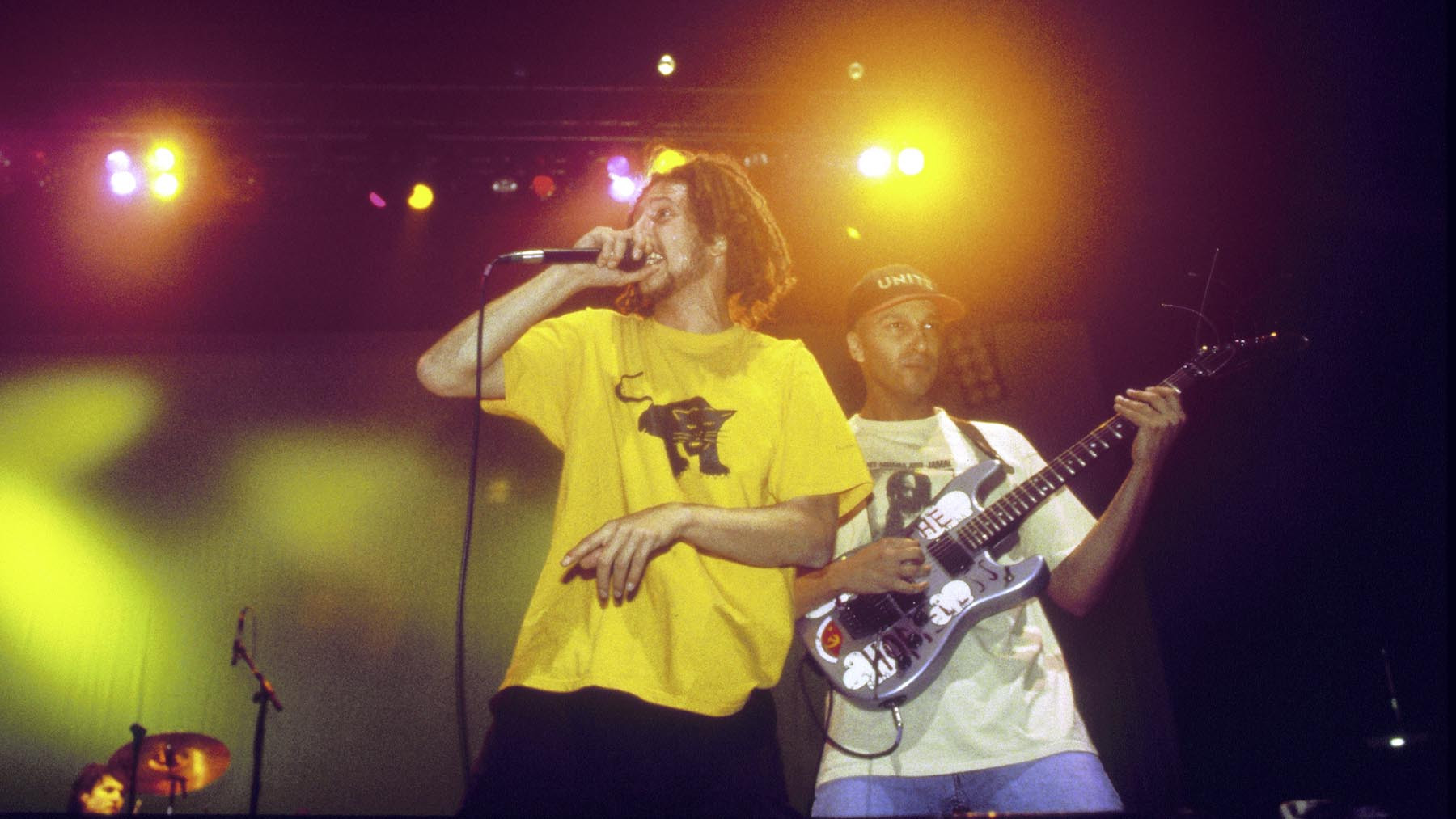 Rage Against The Machine group portrait, circa 2000.
Rage Against The Machine group portrait, circa 2000.
Image Credit: Ebet Roberts/Redferns/Getty Images
Rage Against the Machine first performed Bruce Springsteen’s “The Ghost of Tom Joad” while opening for U2 on the 1997 PopMart stadium tour. Springsteen’s original is a somber and hushed folk ballad depicting urban poverty and resignation. However, Rage transformed it into a powerful rock anthem, reminiscent of their Evil Empire era sound. Tom Morello’s crushing guitar riff bears little resemblance to the folk source material, yet it seamlessly integrates with the song’s spirit. This rendition became a staple of Rage’s live sets until their initial breakup, making it their most frequently played cover song by a significant margin. It was also included on their Renegades covers album in 2000. The song’s impact extended beyond Rage’s performances; in 2008, Morello joined Springsteen and the E Street Band to play a more traditional version, and in 2014, he even temporarily filled in for Steve Van Zandt in the E Street Band. This unlikely collaboration highlights the enduring power and adaptability of “The Ghost of Tom Joad,” as well as Morello’s diverse musical talents. —A.G.
17. ‘Born of a Broken Man’ (1999)
Image Credit: Frank Micelotta/Getty Images
“Born of a Broken Man,” a deeply personal and emotionally resonant track from The Battle of Los Angeles, stands out as one of the most evocative songs in Rage Against the Machine’s catalog. Zack de la Rocha delves into the mental health struggles of his father, the influential Chicano artist Beto de la Rocha. Tom Morello’s guitar rings with a mournful, church bell-like tone, setting a somber and reflective mood. The lyrics, “His thoughts like a hundred moths/Trapped in a lampshade/Somewhere within/Their wings banging and burning/On through the endless night,” are haunting and unforgettable, vividly portraying inner turmoil. However, the song is not solely about suffering; it’s also about resilience. The younger De la Rocha’s defiant mantra, “Born of a broken man, Never a broken man,” is a powerful declaration of breaking cycles of pain and forging one’s own path. —D.E.
16. ‘Wake Up’ (1992)
 Rage Against The Machine performing at the Wetlands Preserve nightclub, New York City, 1992.
Rage Against The Machine performing at the Wetlands Preserve nightclub, New York City, 1992.
Image Credit: Steve Eichner/Getty Images
In six minutes of raw, funky intensity, “Wake Up,” a deep cut from Rage Against the Machine’s debut album, dissects decades of institutional racism within the U.S. government. Zack de la Rocha directly confronts former FBI director J. Edgar Hoover and his policies, condemning the government’s targeting of Dr. Martin Luther King Jr. for protesting the Vietnam War, and asserting that they murdered Malcolm X, attempting to falsely blame it on Islam. The lyrics, “He turned the power to the have-nots, and then came the shot,” are a stark indictment of systemic oppression and violence against activists. The track culminates with de la Rocha screaming “Wake up!” eight times, a powerful climax that, taken out of context, became iconic in the final scene of The Matrix. The song concludes with a quote from Martin Luther King Jr., “How long? Not long, ’cause what you reap is what you sow,” reinforcing the themes of justice and accountability. —K.G.
15. ‘Year of tha Boomerang’ (1996)
Image Credit: Gie Knaeps/Getty Images
“Year of tha Boomerang” offered the first glimpse into Rage Against the Machine’s highly anticipated second album. Originally featured as “Year of the Boomerang” on the soundtrack for John Singleton’s 1994 film Higher Learning, it arrived over 18 months before Evil Empire‘s official release. Inspired by a quote from French anti-imperialist Frantz Fanon, the song serves as a concise lesson on the “doctrines of the right” that de la Rocha would further explore on Evil Empire. These doctrines include imperialism, the oppression of minorities and women, and genocide. Tom Morello’s screeching, riot-siren guitar riff punctuates the song’s urgent and politically charged message, making it a powerful preview of the sonic and lyrical themes of Evil Empire. —D.K.
14. ‘Sleep Now in the Fire’ (1999)
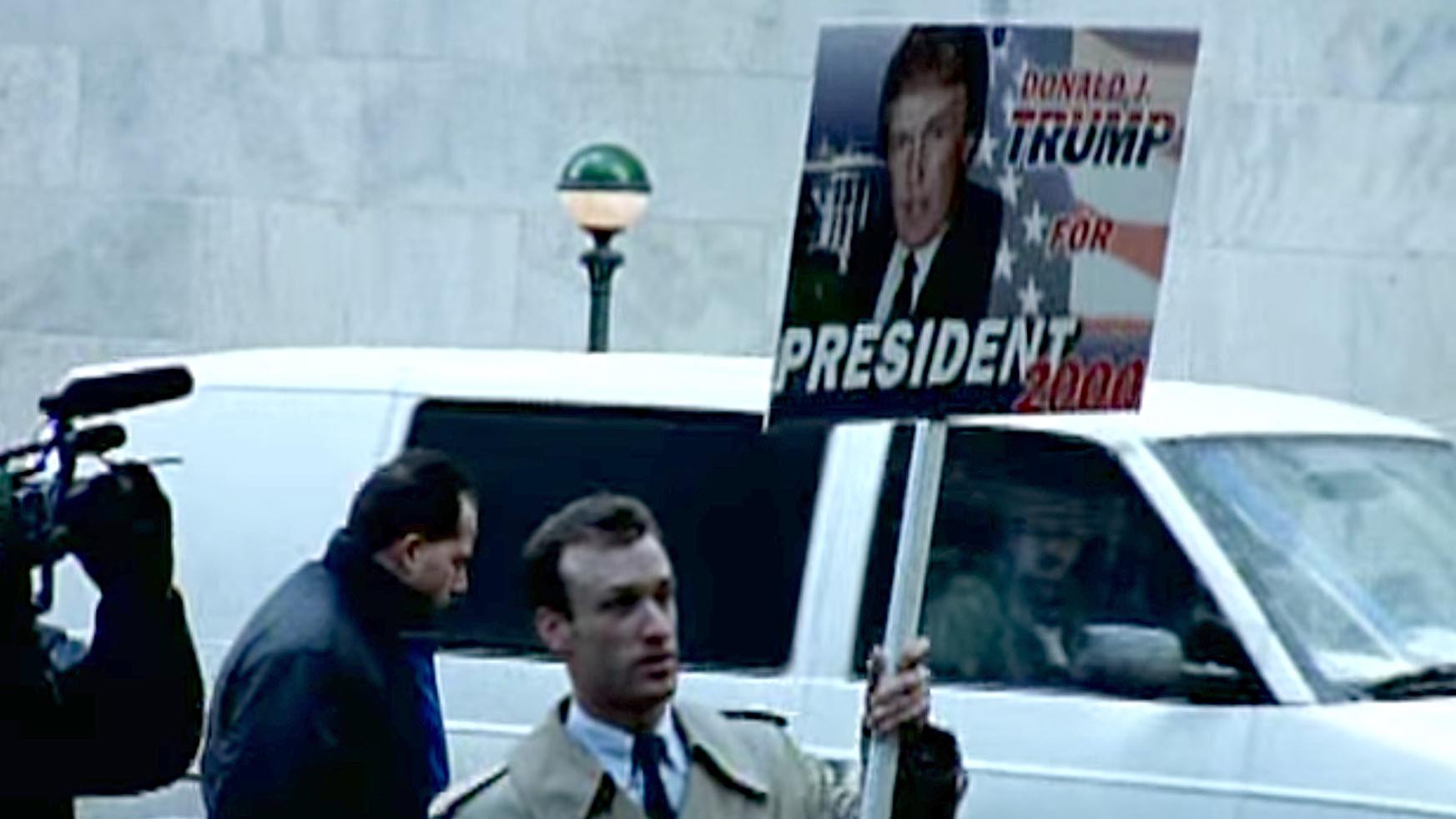 Rage Against The Machine performing "Sleep Now in the Fire" music video shoot.
Rage Against The Machine performing "Sleep Now in the Fire" music video shoot.
Image Credit: Rage Against the Machine/YouTube
“Sleep Now in the Fire” stands as one of Zack de la Rocha’s most potent social and political critiques. The song meticulously traces the devastating impact of American greed on Third World countries and marginalized communities within the U.S. De la Rocha adopts the persona of a Washington powerbroker, singing, “The party blessed me with its future, and I protect it with fire,” highlighting the corrupting influence of power and unchecked ambition. The chorus, driven by Tom Morello’s elastic and searing riff, sarcastically urges the oppressed peoples to “sleep now in the fire,” exposing the brutal realities of exploitation and injustice. The lyrics further catalog the dark legacy of imperialism, slavery, and violence underlying the American myth, with de la Rocha declaring, “I am the Niña, the Pinta, the Santa Maria/The noose and the rapist, the fields’ overseer/The agents of orange, the priests of Hiroshima.” The song’s music video, famously filmed on the steps of the New York Stock Exchange without permission, and featuring a fleeting glimpse of a “Donald J. Trump for President 2000” sign, adds another layer of prescience to its already powerful message. —K.G.
13. ‘Maria’ (1999)
Image Credit: Tim Mosenfelder/Getty Images
“Maria,” a deep cut from The Battle of Los Angeles, showcases the band’s relentless sharpening of their musical and lyrical attack throughout their career. It pairs one of Tom Morello’s heaviest riffs with one of Zack de la Rocha’s most vividly devastating narratives of injustice. De la Rocha tells the harrowing story of Maria, a Mexican woman smuggled into the U.S. as “human contraband” and forced to work in a sweatshop, where she endures abuse from a foreman. Faced with unbearable conditions, Maria chooses a tragic act of suicide on the job rather than continuing to be treated “like cattle.” The song elevates Maria to a martyr figure, her story serving as a constant reminder of North America’s long history of oppression and exploitation. The lyrics, “And through history’s rivers of blood she regenerates/And like the sun disappears only to reappear, Maria, she’s eternally here,” depict her as a symbol of enduring resilience and resistance. The song’s masterful use of dynamics, shifting from hushed verses to explosive choruses driven by Morello’s powerful guitar line, symbolizes Maria’s phoenix-like rebirth and unwavering spirit. —H.S.
12. ‘Vietnow’ (1996)
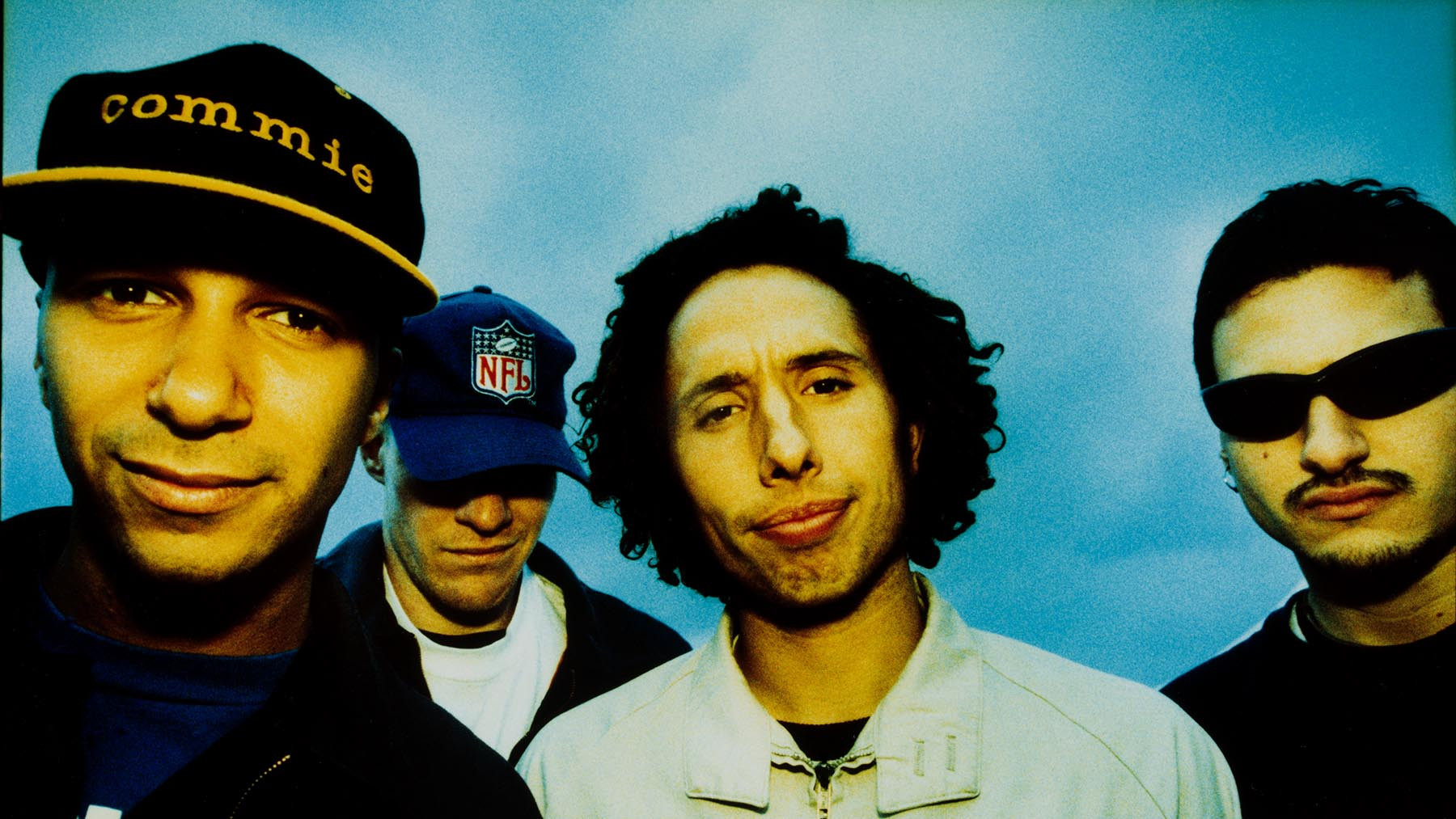 Rage Against The Machine band portrait at Pinkpop Festival, Netherlands, 1996.
Rage Against The Machine band portrait at Pinkpop Festival, Netherlands, 1996.
Image Credit: Niels van Iperen/Getty Images
Predating the rise of Fox News and the QAnon conspiracy theories, Rage Against the Machine’s “Vietnow,” from Evil Empire, directly targeted the insidious influence of right-wing talk radio. The song takes aim at figures like Rush Limbaugh and the hypocritical Christian right, with de la Rocha delivering lyrical jabs like, “Let’s capture this AM mayhem, undressed and blessed by the Lord,” “Terror’s the product you push,” and “The sheep tremble and here come the votes.” The chorus, “Fear is your only god on the radio/Nah, fuck it, turn it off,” is a direct call to reject the fear-mongering and manipulation of right-wing media. As the final single from Evil Empire, “Vietnow” acts as a sonic counterpart to The Battle of Los Angeles‘s lead single, “Guerrilla Radio,” released three years later. While “Guerrilla Radio” urged listeners to “Turn that shit up,” “Vietnow” demanded they “turn it off,” highlighting the band’s nuanced understanding of media’s power to both inform and misinform. —D.K.
11. ‘Bullet in the Head’ (1992)
Image Credit: Lindsay Brice/Getty Image
Rage Against the Machine wrote “Bullet in the Head” during America’s triumphant declaration of victory in the Gulf War, a conflict heavily televised and widely supported. Zack de la Rocha viewed this war as a manufactured spectacle, designed to benefit the military-industrial complex, and saw those who bought into the narrative as brainwashed by media propaganda. The song’s central metaphor is that these individuals have “a bullet in ya head,” their minds poisoned by misinformation. The lyrics, “They say jump and ya say how high, Ya gotta fuckin’ bullet in ya head,” directly address this theme of unquestioning obedience and media manipulation. In early concerts, de la Rocha further clarified the song’s message, stating, “This song is about being an individual, about searching and finding new information, and using your strength as an individual to attack systems like America who continue to rob and rape and murder people in the name of freedom.” “Bullet in the Head” remains a powerful anthem against media manipulation and blind patriotism. —A.G.
10. ‘Down Rodeo’ (1996)
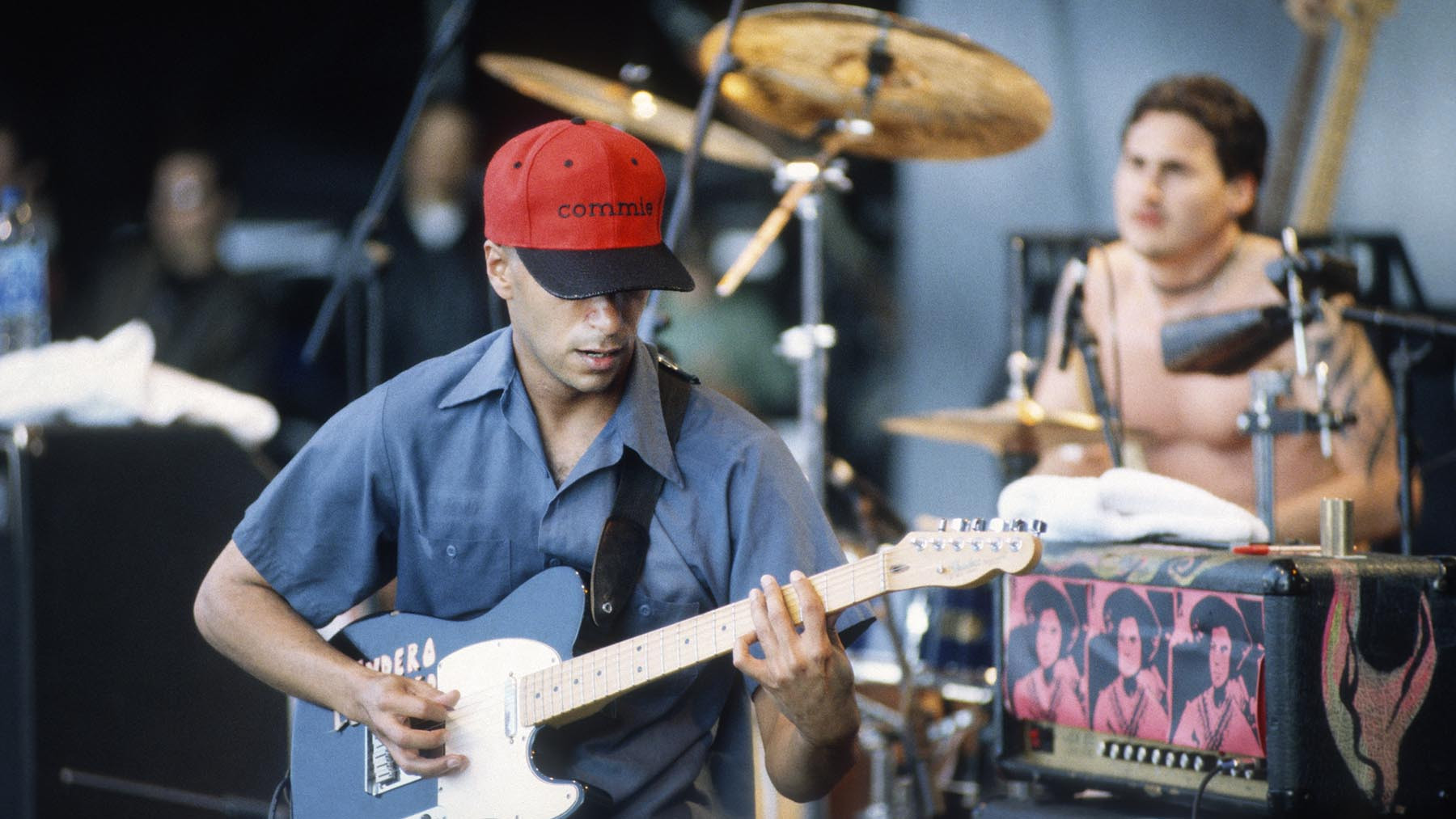 Tom Morello and Brad Wilk of Rage Against The Machine performing at Torhout/Werchter Festival, Belgium, 1996.
Tom Morello and Brad Wilk of Rage Against The Machine performing at Torhout/Werchter Festival, Belgium, 1996.
Image Credit: Gie Knaeps/Getty Images
“Down Rodeo,” a highlight from Evil Empire, uses Rodeo Drive, Beverly Hills’ opulent shopping district, as a backdrop for Zack de la Rocha’s scathing commentary on consumerism, wealth inequality, and socioeconomic segregation. The opening lines, “So now I’m rollin’ down Rodeo with a shotgun,” immediately establish a sense of confrontation and class conflict. The subsequent line, “These people ain’t seen a brown-skin man since their grandparents bought one,” is a particularly biting indictment of racial and economic disparity. Filled with powerful couplets like, “Can’t waste a day/When the night brings a hearse/So make a move and plead the Fifth/‘Cause you can’t plead the First,” and propelled by a swaggering groove, “Down Rodeo” also features Tom Morello’s signature guitar wizardry, including synth-like glitch bursts that build tension throughout the song. The track concludes with de la Rocha’s anguished whisper, “Just a quiet peaceful dance for the things we’ll never have,” as the music fades, leaving a lingering sense of frustration and resignation. —D.E.
9. ‘Freedom’ (1992)
Image Credit: Lindsay Brice/Getty Images
Fueled by one of the most iconic guitar riffs since Black Sabbath’s Tony Iommi, “Freedom” is a direct call for the release of Leonard Peltier, a Native American activist imprisoned for the deaths of two FBI agents in 1975, a crime he maintains he did not commit. The song’s raw energy and political message are inseparable. Zack de la Rocha’s passionate screams of “Freedom, yeah!” at the song’s climax, followed by the sarcastic revision, “Freedom, yeah right!,” underscore the song’s critical stance on justice and systemic oppression. The music video for “Freedom” further amplified its message, displaying the words “We demand and support the request that Leonard Peltier … be released. Justice has not been done.” during the breakdown. De la Rocha emphasized the band’s intention, stating in 1996, “What we are trying to show is that people can make a difference … that we aren’t all powerless.” “Freedom” is both a powerful song and a call to action, highlighting Rage Against the Machine’s commitment to social justice and activism. —K.G.
8. ‘Testify’ (1999)
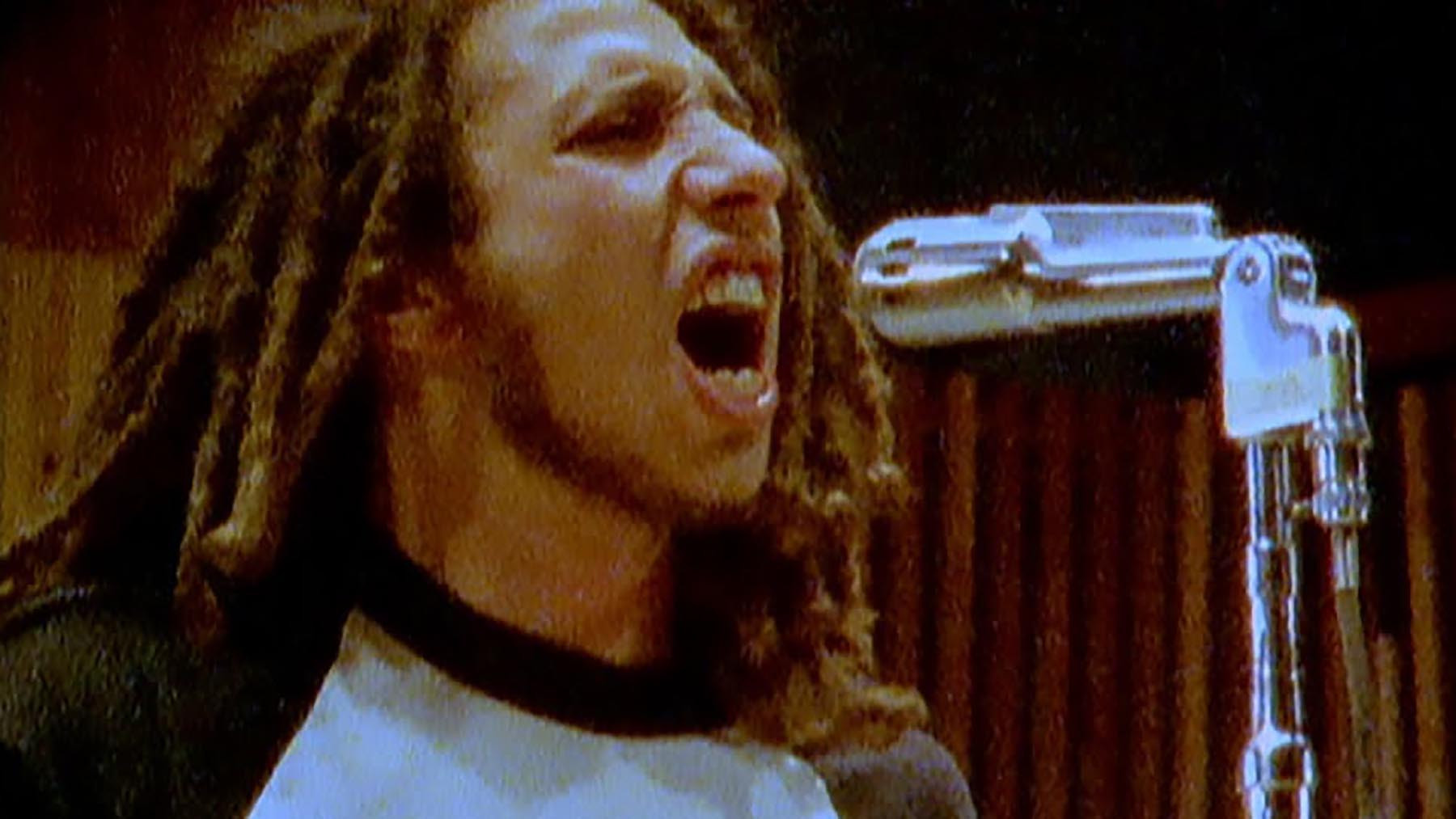 Rage Against The Machine performing "Testify" music video shoot.
Rage Against The Machine performing "Testify" music video shoot.
Image Credit: Rage Against the Machine/YouTube
“Testify” served as the explosive opening track of Rage Against the Machine’s third album, The Battle of Los Angeles, which Rolling Stone hailed as the Best Album of 1999. Initially titled “Hendrix” due to its use of a “Purple Haze” chord progression, Tom Morello later humorously noted the connection to Jimi Hendrix’s early song “Testify.” The song evolved into a sharp critique of the impending 2000 presidential election, targeting the perceived ideological homogeneity of candidates George W. Bush and Al Gore. The lyrics suggest that both candidates, despite their different party affiliations, ultimately represent the same capitalist interests. The Michael Moore-directed music video for “Testify” mirrored this pre-election anxiety and featured a prescient quote by Ralph Nader, whose Green Party candidacy is often seen as a pivotal factor in the outcome of the 2000 election, inadvertently contributing to Bush’s victory. “Testify” is a powerful and politically charged track that captures the band’s skepticism towards mainstream politics and their call for radical change. —D.K.
7. ‘Take the Power Back’ (1992)
Image Credit: Lindsay Brice/Getty Images
“Take the Power Back,” a funky and defiant anthem from Rage Against the Machine, takes the protest spirit of Public Enemy and the Isley Brothers a step further. It not only encourages resistance against oppressive powers but also emphasizes that the power rightfully belongs to the people in the first place. Decades before the 1619 Project, Zack de la Rocha directly challenged the Eurocentric bias in U.S. education. The lyrics, “One-sided stories for years and years and years/I’m inferior?/Who’s inferior?/Yeah, we need to check the interior/Of the system that cares about only one culture,” critique the systemic erasure of diverse perspectives in education. The song’s driving energy comes from the fiery interplay of Brad Wilk’s powerful drumming, Tim Commerford’s slinky basslines, and Tom Morello’s sharp, stabbing guitar chords. “Take the Power Back” is a call for empowerment and a demand for a more inclusive and truthful understanding of history and power dynamics. —D.E.
6. ‘Bombtrack’ (1992)
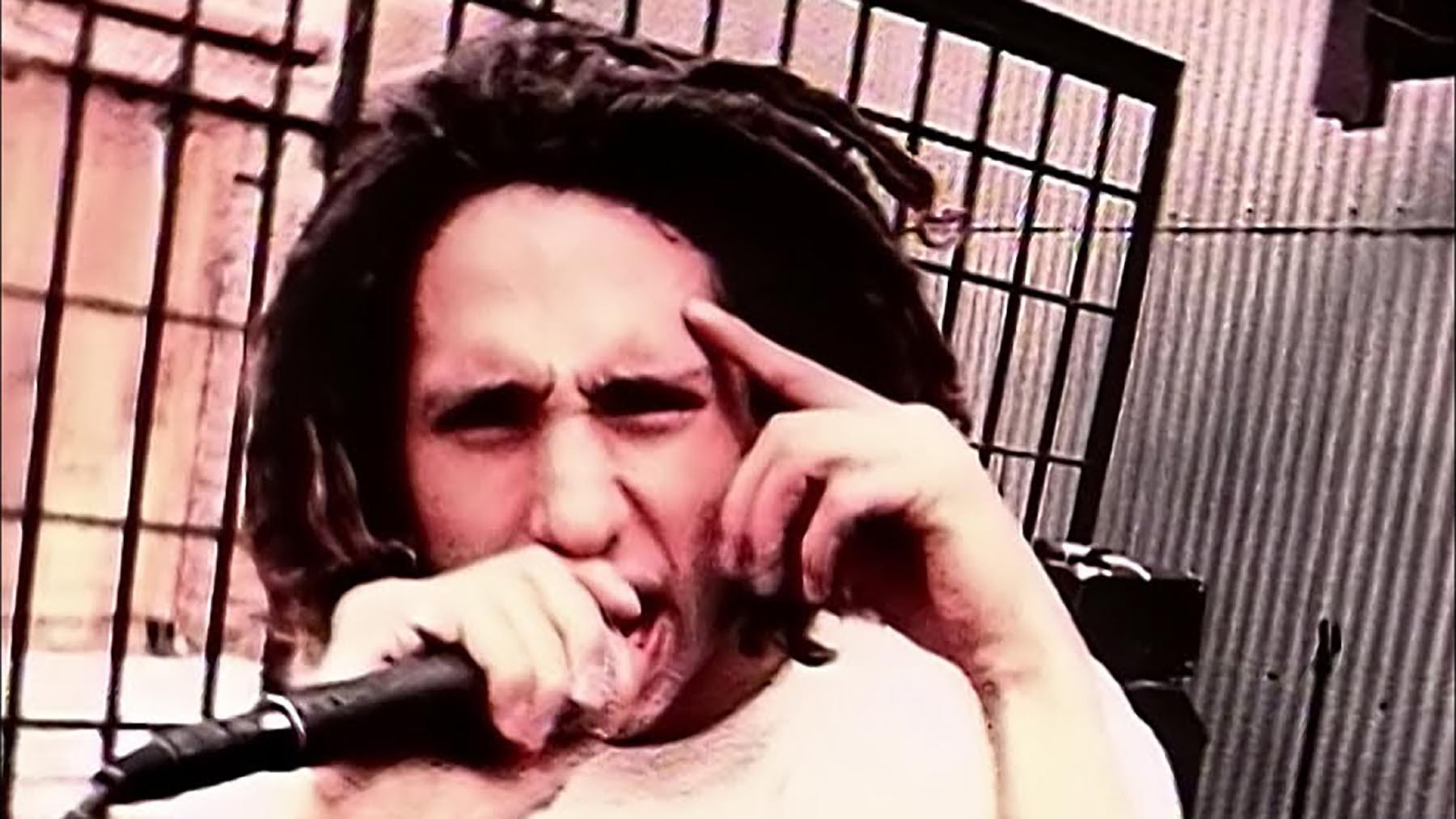 Rage Against The Machine performing "Bombtrack" music video shoot.
Rage Against The Machine performing "Bombtrack" music video shoot.
Image Credit: Rage Against the Machine/Youtube
Rage Against the Machine wasted no time establishing their confrontational stance, opening their 1992 self-titled debut album with the explosive “Bombtrack.” While the official music video paid tribute to the guerilla group Sendero Luminoso (Shining Path) and their fight against Peru’s oppressive, U.S.-backed government, the song’s message extends beyond a specific conflict. “Bombtrack” is a broader declaration of solidarity with indigenous peoples worldwide who have suffered abuse, exploitation, and violence in the name of imperialism. Zack de la Rocha’s powerful lyrics, “Enough/I call the bluff/Fuck Manifest Destiny,” and “Landlords and power whores/On my people/They took turns/Dispute the suits/I ignite and then watch ‘em burn,” are a visceral rejection of imperialist ideologies and a pledge of resistance and retribution. “Bombtrack” is a potent statement of anti-imperialism and a powerful opening for one of the most impactful debut albums in rock history. —D.E.
5. ‘People of the Sun’ (1996)
Image Credit: Niels van Iperen/Getty Images
Inspired by the 1994 Zapatista uprising in Chiapas, Mexico, “People of the Sun” is a furious and concise burst of energy from Evil Empire. The song prophesies a resurgence of indigenous power, invoking Cuauhtémoc, the last Aztec emperor, with the lyrics, “The fifth sun sets/Get back/Reclaim/The spirit of Cuauhtémoc/Alive and untamed.” It serves as a powerful reminder of both Spain’s brutal 16th-century conquest of Mexico and the racist Zoot Suit Riots in 1940s Los Angeles. Clocking in at a mere two minutes and thirty seconds, “People of the Sun” is the shortest song in Rage Against the Machine’s entire catalog, but its compact intensity makes it the perfect opening track for Evil Empire. It’s a concentrated dose of rage and historical awareness, showcasing the band’s ability to deliver impactful messages with brevity and force. —D.E.
4. ‘Guerrilla Radio’ (1999)
 Zack de la Rocha and Tim Commerford of Rage Against The Machine performing at Tibetan Freedom Concert, San Francisco, 1996.
Zack de la Rocha and Tim Commerford of Rage Against The Machine performing at Tibetan Freedom Concert, San Francisco, 1996.
Image Credit: Tim Mosenfelder/Getty Images
“Guerrilla Radio,” the lead single from The Battle of Los Angeles, draws a powerful analogy between underground radio stations used by Latin American guerilla movements in the 1980s and Rage Against the Machine’s own grassroots approach to building a fanbase. Just as stations like Radio Venceremos in El Salvador served to communicate and unite resistance movements, Rage saw their music as a form of sonic resistance against mainstream media that largely ignored their politically charged message. Released as the 2000 election began to intensify, the song directly criticizes both major candidates, George W. Bush and Al Gore, with the lines, “More for Gore or the son of a drug lord, None of the above/Fuck it, cut the cord.” “Guerrilla Radio” concludes with a fervent call for revolution, “It has to start somewhere, it has to start sometime/What better place than here, what better time than now?” The song’s title and message encapsulate Rage Against the Machine’s ethos of using music as a weapon for social change and their belief in the power of grassroots movements. —A.G.
3. ‘Know Your Enemy’ (1992)
Image Credit: Mark Baker/Sony Music Archive/Getty Images
“Know Your Enemy” remains a quintessential Rage Against the Machine track, perfectly blending a killer, upbeat funk-metal riff by Tom Morello with Zack de la Rocha’s furious anti-authoritarian manifesto. Lines like, “Cause I’ll rip the mic, rip the stage, rip the system/I was born to rage against ‘em,” are declarations of defiance against systemic oppression. De la Rocha makes the target of his rage explicit, asking, “What? The land of the free? Whoever told you that is your enemy.” Musically, “Know Your Enemy” is one of the most dynamic tracks from their early work. It features a festive, slap-bass driven intro, and a moody bridge with guest vocals from Tool frontman Maynard James Keenan and percussion by Jane’s Addiction drummer Stephen Perkins. The song’s brilliant climax around the four-minute mark, with Commerford’s grinding bass, Morello’s siren-like guitar, and de la Rocha’s grunt of “Come on!”, creates an explosive sonic moment, perfectly embodying the song’s call for radical action and defiance against authority. —H.S.
2. ‘Killing in the Name’ (1992)
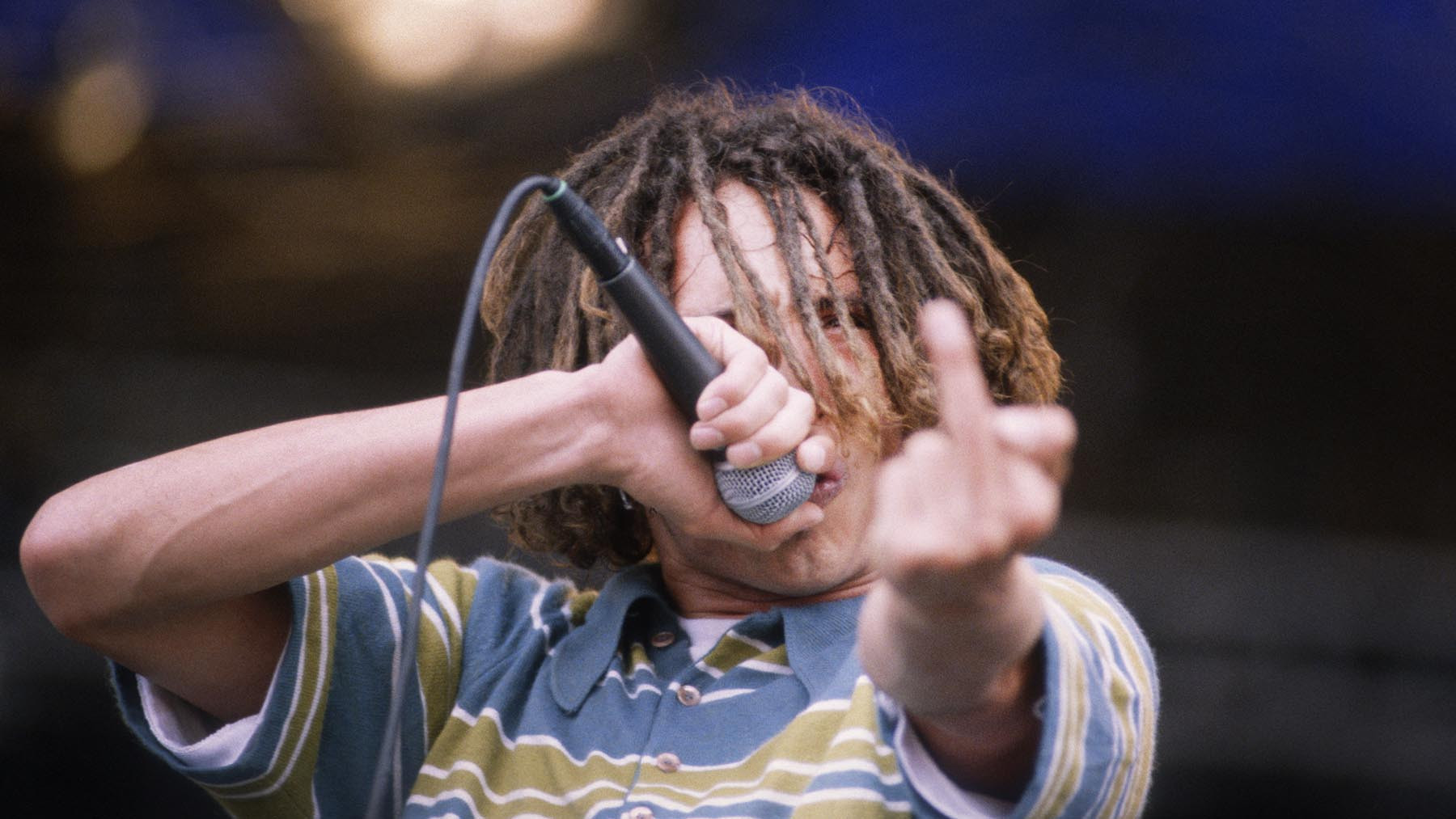 Zack De La Rocha of Rage Against The Machine performing at Pinkpop Festival, Netherlands, 1993.
Zack De La Rocha of Rage Against The Machine performing at Pinkpop Festival, Netherlands, 1993.
Image Credit: Gie Knaeps/Getty Images
In 1991, the acquittal of four white LAPD officers in the Rodney King beating case ignited the Los Angeles riots, and Zack de la Rocha channeled his outrage into the lyrics of “Killing in the Name.” Inspired by N.W.A’s confrontational “Fuck tha Police,” “Killing in the Name” is a funky and furious update of the protest anthem, directly addressing police racism and the cycle of violence perpetrated by those in power. The repeated chant, “Some of those that work forces, Are the same that burn crosses,” powerfully connects police brutality to systemic racism and historical oppression. As the song intensifies, de la Rocha’s lyrics become even more pointed, “Those who died are justified for wearing the badge/They’re the chosen whites,” directly confronting the racial bias within law enforcement. The song culminates in de la Rocha’s repeated scream, “Fuck you, I won’t do what you tell me,” sixteen times, solidifying its place as one of history’s most incendiary protest songs. Tom Morello recalled record executives’ bewildered reaction to the song early in the band’s career, highlighting its raw power and uncompromising message. —K.G.
1. ‘Bulls on Parade’ (1996)
Image Credit: Gie Knaeps/Getty Images
Rage Against the Machine titled their second album Evil Empire, and many of its songs, including “Bulls on Parade,” focused on critiquing American foreign policy and the corrupting influence of power. In “Bulls on Parade,” Zack de la Rocha, accompanied by Tom Morello’s ingeniously minimalist and instantly recognizable riff, directs his lyrical fire at the hypocrisy of Washington D.C. policymakers. The iconic lines, “Weapons not food, not homes, not shoes, Not need, just feed the war cannibal animal,” starkly expose the misplaced priorities of a government that prioritizes military spending over basic human needs. De la Rocha further indicts politicians who feign family values while secretly supporting war and violence, having a “pocket full of shells.” Near the song’s climax, Tom Morello unleashes a career-defining guitar solo, masterfully replicating the sound of a record scratch, further pushing the boundaries of guitar playing and sonic innovation. Taken as a whole, “Bulls on Parade” is perhaps the most perfect distillation of Rage Against the Machine’s sonic Molotov cocktail – a potent blend of furious energy, political outrage, and musical innovation. A legendary performance of “Bulls on Parade” took place outside the Democratic National Convention in 2000, just months before the band’s initial breakup, underscoring their unwavering commitment to challenging power structures and speaking truth to power. De la Rocha’s words before that performance, “Brothers and sisters, our electoral freedoms in this country are over so long as it’s controlled by corporations… we are not going to allow these streets to be taken over by Democrats or Republicans,” remain chillingly relevant today. —A.G.
